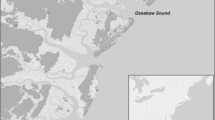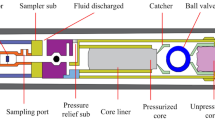Abstract
Scientific sea-floor dredging is currently used in marine geology primarily by the “hard-rock” community interested in the recovery of basement rock samples from the unsedimented deep ocean floor. The technique has generally been eclipsed by ocean drilling for recovery of sedimentary rocks, because of perceived uncertainties in the location of sampling and in the representativeness of recovered material. This contribution reviews dredging equipment currently in use by marine geological institutions and refers to pinger attachments that allow precise information on the behaviour of the dredge to be telemetered back to the ship. We argue that improvements in ship navigation and transponder navigation at the seafloor, when used in conjunction with surface and/or deeply towed sidescan and swathemapping surveys, now allow for considerably less uncertainty on the location of dredge sampling. Refined sorting criteria for dredge hauls are now also available. Recent comparisons of regional sample recovery by ocean drilling and by dredge sampling indicate that the dredge hauls can usefully supplement the drilling data in the construction of sedimentary and tectonic histories of seafloor areas.
Similar content being viewed by others
References
Aumento F., 1970, Improved Positioning of Dredges on the Seafloor, Can. J. Earth Sci. 7, 534–539.
Aumento F. and Lawrence D. E., 1968, Photographic Control of Deep Sea Dredging, Geol. Surv. Can. Paper 68 (9), pp. 1–3.
Boillot G., Winterer E. L., and Meyer A. W. et al., 1987, Proc. ODP ‘Initial Reports’ 103: College Station TX, (Ocean Drilling Program) 809–828.
Burt, R. G., 1979, Handling Oceanographic Equipment: Notes and Sketches from a Netman's Log, Institute of Oceanographic Sciences Report 34, 62 pp.
Cronan D. S., 1980, Underwater Minerals, Academic Press, London, 362 pp.
Emery K. O., 1963, Organic Transportation of Marine Sediments, in M. N. Hill (ed.), The Sea, Vol. 3. Wiley and Sons, New York, pp. 776–789.
Emery K. O. and Tschundy R. H., 1941, Transportation of Rock by Kelp, Geol. Soc. Amer. Bull. 52, 855–862.
Fillippov, L. A., Krausch, A., Barash, M. S., Laurov, V. M. and Dmitriyea, L. V., 1970, A Large Cylindrical Dredge, Oceanology, 140–142.
Fox P. J. and Stroup, 1981, The Plutonic Foundation of the Oceanic Crust, in Emiliani C. (ed.), The Oceanic Lithosphere, Vol VII, The Sea: Ideas and Observations on Progress in the Study of the Sea, J. Wiley and Sons, New York, pp. 119–218.
Gaunt D. I. and Wilson J. B., 1975, Acoustic Monitoring of Dredge Behaviour on the Sea Floor, Deep Sea Res. 22, 91–97.
Huggett Q. J. and Kidd R. B., 1983/84, Identification of Ice-Rafted and Other Exotic Material in Deep Sea Dredge Hauls, Geo-Marine Letters 3, 23–29.
Kastens K. A., Mascle J., Auroux C. et al., 1987, Proc. ODP Initial Reports 107: College Station TX (Ocean Drilling Program).
Kidd R. B. and Huggett Q. J., 1981, Rock Debris on Abyssal Plains in the Northwest Atlantic: A Comparison of Epibenthic Sledge Hauls and Photographic Surveys, Oceanologica Acta, 4, 99–104.
Kidd, R. B. and Ramsay, A. T. S. 1986, The Geology and Formation of the King's Trough Complex in the Light of Deep Sea Drilling Project. Site 608 Drilling, in Ruddiman, W. F., Kidd, R. B., Thomas, E., et al., Init. Repts. of Deep Sea Drilling Project, Vol. 94, Washington, pp. 1245–1261.
Kidd R. B., Searle R. C., Ramsay A. T. S., Pritchard H., and Mitchell J., 1982, The Geology and Formation of King's Trough Northeast Atlantic Ocean, Marine Geology, 48, 1–30.
Kinoshita, Y., Maruyama, S., Honza, E., Yamakado, N., Usami, T., and Handa, K., 1975, Technical Notes on Deep Sea Bottom Sampling, in Mizuno, A. et al., Cruise Report No. 4. Deep Sea Mineral Resources Investigation in the Eastern Central Pacific Basin. Geol. Surv. Japan, 49–61.
Laughton A. S. et al., 1971, RRS Discovery Cruise 33, N.I.O. Cruise Report No 33, National Inst. of Oceanography, Wormley, Surrey, 23 pp.
Loncarevic, B. D., 1969, Buoy Plot as a Survey Aid. Trans. Applications of Sea-Going Computers Symposium. Mar. Tech. Soc., Washington D.C., pp. 27–33.
Nalwalk A. J., Hersey J. B., Reitzel J. S., and Edgerton H., 1961, Improved Techniques of Deep-Sea Rock-Dredging, Deep Sea Res. 8, 301–302.
Somers M. L., Carson R. M., Revie J. A., Edge R. H., Barrow B. J., and Andrews A. G., 1978, GLORIA II—An Improved Long-Range Sidescan Sonar, Proc. IEEE/IERE Sub-Conference on Offshore Instrumentation and Communications, OCEANOL. INT. 1978, Tech. Sess. J., BPS Publications Ltd., London, pp. 16–23.
Author information
Authors and Affiliations
Rights and permissions
About this article
Cite this article
Kidd, R.B., Huggett, Q.J. & Ramsay, A.T.S. The status of geological dredging techniques. Marine Geophysical Researches 12, 131–143 (1990). https://doi.org/10.1007/BF00310568
Received:
Accepted:
Issue Date:
DOI: https://doi.org/10.1007/BF00310568




